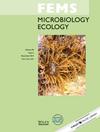Multiomics data integration, limitations, and prospects to reveal the metabolic activity of the coral holobiont.
IF 3.5
3区 生物学
Q2 MICROBIOLOGY
引用次数: 0
Abstract
Since their radiation in the Middle Triassic period ∼ 240 million years ago, stony corals have survived past climate fluctuations and five mass extinctions. Their long-term survival underscores the inherent resilience of corals, particularly when considering the nutrient-poor marine environments in which they have thrived. However, coral bleaching has emerged as a global threat to coral survival, requiring rapid advancements in coral research to understand holobiont stress responses and allow for interventions before extensive bleaching occurs. This review encompasses the potential, as well as the limits, of multiomics data applications when applied to the coral holobiont. Synopses for how different omics tools have been applied to date and their current restrictions are discussed, in addition to ways these restrictions may be overcome, such as recruiting new technology to studies, utilizing novel bioinformatics approaches, and generally integrating omics data. Lastly, this review presents considerations for the design of holobiont multiomics studies to support lab-to-field advancements of coral stress marker monitoring systems. Although much of the bleaching mechanism has eluded investigation to date, multiomic studies have already produced key findings regarding the holobiont's stress response, and have the potential to advance the field further.揭示珊瑚全生物体代谢活动的多组学数据整合、局限性和前景。
石珊瑚自 2.4 亿年前的三叠纪中期开始辐射以来,经历了历次气候波动和五次大灭绝。它们的长期生存彰显了珊瑚与生俱来的韧性,尤其是考虑到它们曾在营养匮乏的海洋环境中繁衍生息。然而,珊瑚白化已成为珊瑚生存的全球性威胁,这要求珊瑚研究取得快速进展,以了解整体生物的应激反应,并在大面积白化发生之前进行干预。本综述涵盖了多组学数据应用于珊瑚全缘体的潜力和局限性。除了讨论克服这些限制的方法(如在研究中采用新技术、利用新型生物信息学方法以及全面整合多组学数据)外,还简要介绍了迄今为止如何应用不同的多组学工具及其目前的限制。最后,本综述介绍了设计全生物体多组学研究的注意事项,以支持珊瑚压力标记监测系统从实验室到现场的进步。虽然到目前为止,许多白化机制还没有得到研究,但多组学研究已经产生了有关全缘体应激反应的重要发现,并有可能进一步推动该领域的发展。
本文章由计算机程序翻译,如有差异,请以英文原文为准。
求助全文
约1分钟内获得全文
求助全文
来源期刊

FEMS microbiology ecology
生物-微生物学
CiteScore
7.50
自引率
2.40%
发文量
132
审稿时长
3 months
期刊介绍:
FEMS Microbiology Ecology aims to ensure efficient publication of high-quality papers that are original and provide a significant contribution to the understanding of microbial ecology. The journal contains Research Articles and MiniReviews on fundamental aspects of the ecology of microorganisms in natural soil, aquatic and atmospheric habitats, including extreme environments, and in artificial or managed environments. Research papers on pure cultures and in the areas of plant pathology and medical, food or veterinary microbiology will be published where they provide valuable generic information on microbial ecology. Papers can deal with culturable and non-culturable forms of any type of microorganism: bacteria, archaea, filamentous fungi, yeasts, protozoa, cyanobacteria, algae or viruses. In addition, the journal will publish Perspectives, Current Opinion and Controversy Articles, Commentaries and Letters to the Editor on topical issues in microbial ecology.
- Application of ecological theory to microbial ecology
- Interactions and signalling between microorganisms and with plants and animals
- Interactions between microorganisms and their physicochemical enviornment
- Microbial aspects of biogeochemical cycles and processes
- Microbial community ecology
- Phylogenetic and functional diversity of microbial communities
- Evolutionary biology of microorganisms
 求助内容:
求助内容: 应助结果提醒方式:
应助结果提醒方式:


